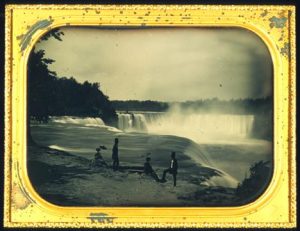
![]() Niagara Falls comprises three waterfalls that straddle the border between the United States and Canada. The falls were formed at the end of the last ice age, when the north polar cap covered most of Canada in a huge sheet of ice. As the ice receded, its melt water pooled into the Great Lakes, and through erosion the falls were formed.
Niagara Falls comprises three waterfalls that straddle the border between the United States and Canada. The falls were formed at the end of the last ice age, when the north polar cap covered most of Canada in a huge sheet of ice. As the ice receded, its melt water pooled into the Great Lakes, and through erosion the falls were formed.
Aboriginal peoples discovered Niagara Falls thousands of years ago, and by the early 1600s Iroquoian and other tribes settled the Niagara peninsula. Following the War of 1812, the region rapidly developed. In the face of economic exploitation by tourism, hydropower, and manufacturing, the Niagara Reservation was created in 1883 as the first state park, marking an early triumph for the conservation movement.
From their initial encounters with Niagara Falls, Europeans and their American descendants stood in awe in front of this natural spectacle, admiring its sublime evidence of the powers of the Divine in nature. With the completion of the Erie Canal in 1825, Niagara Falls became easily accessible to tourists who brought back souvenirs of their visit to this wonderful place. By the 1850s, these souvenirs included photographs.
![]() Platt D. Babbit, an early photographer who used the daguerreotype process, controlled the lucrative pavilion area known as Point View on the American side of the Falls. Babbitt chased off competitors who also wished to set up photographic businesses at the pavilion. “Mr. Babbitt and his forces would stand between the camera and the falls swinging large-sized umbrellas to and fro thus preventing [the other photographer] from getting a picture,” wrote an observer.[footnote]http://www.getty.edu/art/collection/artists/2800/platt-d-babbitt-american-1823-1879/. Accessed 11/10/16.[/footnote]
Platt D. Babbit, an early photographer who used the daguerreotype process, controlled the lucrative pavilion area known as Point View on the American side of the Falls. Babbitt chased off competitors who also wished to set up photographic businesses at the pavilion. “Mr. Babbitt and his forces would stand between the camera and the falls swinging large-sized umbrellas to and fro thus preventing [the other photographer] from getting a picture,” wrote an observer.[footnote]http://www.getty.edu/art/collection/artists/2800/platt-d-babbitt-american-1823-1879/. Accessed 11/10/16.[/footnote]
Although Babbitt would often photograph tourists without their knowledge, later selling them their daguerreotypes as keepsakes, in this example two well-dressed couples seem carefully posed. Frozen in a kind of tableau vivant, the figures are in profile and the woman on the left carefully holds her parasol away from her face. For the multi-second exposure, they hold themselves rigidly still as the flowing water blurs behind them.